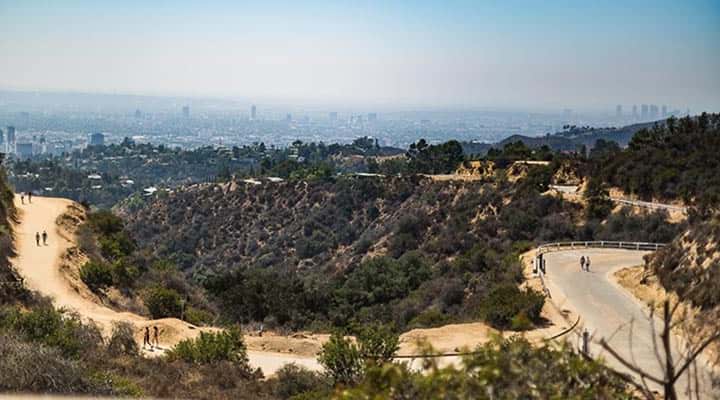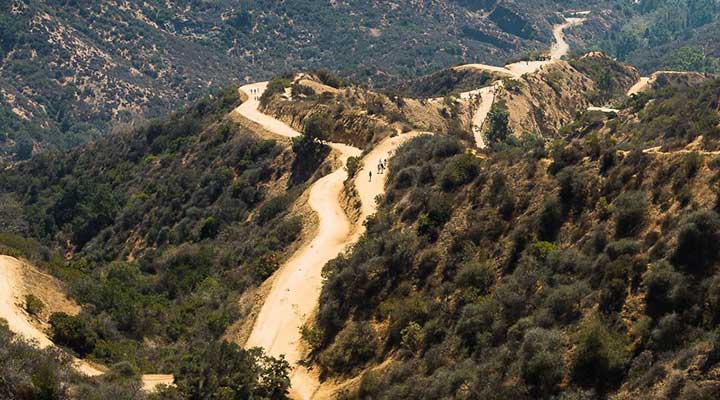
How to Pack a Backpack Like it’s Second Nature
Jul 14, 2023 / Alyssa Duranty
When photographer Matt Doheny moved from the seaside town of Newport Beach to the urban streets of central Los Angeles, he decided to trade his daily surf sessions for hikes to the Hollywood sign in Griffith Park.
Recently, he spent nearly three hours hiking with his friends and Faly, a white dachshund that looks like Falkor the luck dragon from the NeverEnding Story.
“It was fun; it was hot and it was hard, but we did it,” Doheny said.
He hopes to start hiking at least twice a week, and plans to head out on more rural paths.
But before he heads out to less-populated trails, he needs to know how to pack a backpack to be prepared for dangerous hiking situations. And lucky for him, we’ve got an expert hiker tips for the rest of us.
Sierra Club member Emmy Goldknopf is so knowledgeable that she leads group hikes for the organization and offers tips along the way on what to pack to stay safe and enjoy nature–no matter how short the hike.
Pack Enough Water for Your Day Hike
Water is the most important supply you can have in your backpack. If you can, carry an extra bottle and electrolyte packets in case of mid-hike fatigue.
“I use a hydration unit, and I carry a small bottle of extra water on little hikes,” said Goldknopf, who has hiked up Mount Baldy – the highest point in Los Angeles County – five times.
Doheny said two bottles of water was enough for his afternoon hike, but on longer or more exhausting trails he should have brought more, according to our expert advice.
Bring a Map and Compass and Know How to Use Them
Do not rely on electronics to get you back to civilization safety. You never know if your cellphone will fall out of your hand during a mid-nature selfie.
It also helps if your compass has a mirror on it, in case you need signal for help using the sun’s glare.
“I’ve been to a couple places where I had a crappy map, but it was better than no map,” Goldknopf said.
Protect Yourself from the Sun During Hikes
Even if you plan to hike at night or in the late afternoon, you should bring hats, sunglasses and sunscreen in case you find yourself on an unexpected campout.
Doheny, a pale redhead of Irish heritage, was smart and slathered sunscreen on before he headed up the dirt roads, so he returned back to the busy Los Angeles streets without a sunburn.
Pack Extra Clothes before Hiking Just in Case
Pack at least a lightweight jacket, because having extra clothes could mean extra comfort and safety in case the weather is cooler than expected in higher elevations.
“Once I hiked near Mount Wilson in the winter, and once I got to where we were going it was 35 degrees and windy,” Goldknopf said. “I realized you really have to be prepared if you’re in the mountains.”
Also make sure you wear nylon, or other quick-drying materials before the hike starts. Avoid cotton clothes because they will absorb your sweat and can stay wet for hours.
Bring Materials to Start a Fire on a Hike
Don’t start a fire unless absolutely necessary. Think of Smokey the Bear. Only you can prevent wildfires.
But having the means to start at fire for warmth, just in case, is very important, especially in colder, wetter climates and seasons or higher elevations. A pack of matches take up little-to-no room and could help save your life.
Bring Snacks and Extra Food for Energy During Day Hikes
It’s always a good idea to carry extra granola bars or snacks in case hunger strikes and fast food isn’t an option.
Equipped with a couple of cookie-flavored energy bars and some trail mix, Doheny and his friends made it through their Griffith Park hike. Faly the dog on the other hand had to be carried in their backpack back down to the car. While dogs are not a backpack essential, sometimes the backpack is essential to the dog.
And don’t forget water and snacks for your pup!
Carry a Compact First-Aid Kit In Case of Injuries on the Trail
Nature is a beast, and you never know when you might slip, fall and sprain something important. Having a stash of bandages, burn creams and pain reliever never hurts.
Goldknopf recommends anyone who plans to start hiking as a hobby to take the Sierra Club’s Wilderness Travel Course.
“What’s also important is knowing how to use (everything in your kit),” she said.
Bring a Knife or Tool Kit in Your Hiking Backpack
A multi-tool or pocket knife can help clear your path off the beaten trail, as well as provide a way to open that extra food or electrolyte packets.
“You don’t need a huge knife,” Goldknopf said. “Just make sure when you use it, you put it back in your pack. If you put something down in a wilderness area, it’s really easy to forget it.”
Bring Shelter in Case You’re Stuck Out in the Cold During a Hike
Getting stuck on a hike sounds bad. Getting stuck and becoming cold sounds worse. Pack an emergency space blanket just in case. It’s worth the small space it will take up.
“A day hike might not turn out to be a day hike,” Goldknopf said. “I know people who have gone hiking and had to stay the night because they couldn’t safely hike down at night.”
Carry a Flashlight and Extra Batteries During Hikes
Losing the ability to see, especially in an area where wild animals like to live and eat, is a scary thought. It’s worth it to pack a flashlight, in case the sun sets before you get back to home base.
Goldknopf stores all 10 essentials and extras like bug spray and a bandana in her 22-liter backpack, so she doesn’t leave anything behind. Storing the filled backpack at home with her hiking shoes helps her head out the door and onto the trails fast.
“You may have things you’re dealing with and when you get on the trail most of that goes away,” Goldknopf said. “I tend to relax. After a half-hour, everything else falls far away and at least you’re in this nice place. At least for a little while.”
Now that you’ve conquered a short trip outdoors, read our guide for some DIY camping storage tips for a longer stay. We also have some great camping storage solutions to make packing easier. Happy Trails!
Photos courtesy of Matt Doheny Photography








